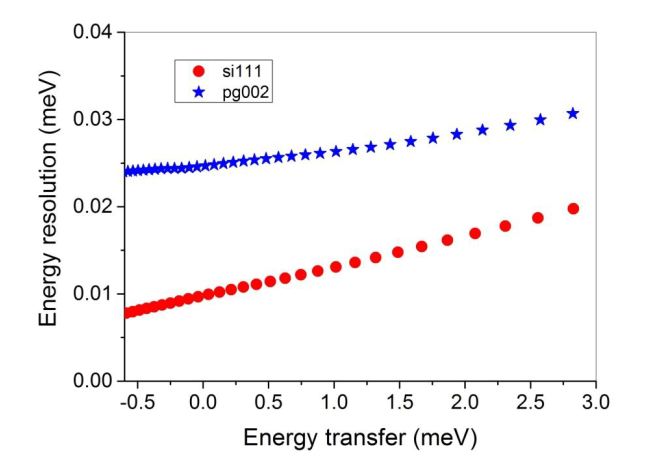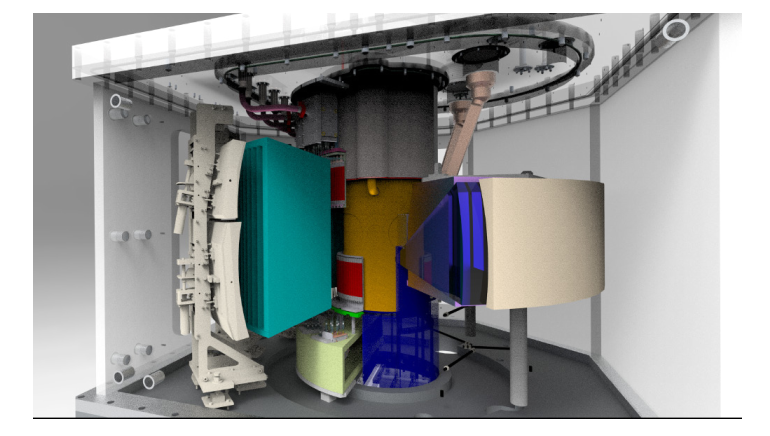OSIRIS is currently being upgraded with the addition of a silicon analyser, positioned on the vacant side inside the vacuum tank of the secondary spectrometer. The current pyrolithic graphite analysers (PGA) on OSIRIS provides a maximum spectral resolution of about 25 µeV (pg002) at the elastic line, enabling access to relaxation times up to 140 ps. Using the (111) reflection plane of silicon analyser, OSIRIS will extend these timescales to ca. 400 ps as a result of an improvement in spectral resolution by a factor of 2.5 (resolution of 11 µeV). This development increases the dynamic range of the instrument to ca. 1,000. An inherent advantage of the silicon analyser is that such an increase in spectral resolution does not affect the wide momentum-transfer range currently available on the instrument. Moreover, the use of position-sensitive detector technology will also enable access to four-dimensional data sets, of particular relevance to single-crystal studies. The current PGA can only provide three-dimensional data. The silicon analyser can be operated simultaneously with the existing pyrolytic graphite analyser bench. The solid angle of the silicon analyser is about 2sr and hence will be nearly twice the present one.
Access to longer relaxation times would provide
new opportunities to strengthen the science programme in ionic and proton
conduction in complex media, or molecular transport in porous materials and
catalysts of industrial relevance, which quite often suffer from present limits.
 For example, studying the ionic
conductivity in novel battery materials is at the limit of present capabilities
of the PG analyser. However, an increase of the energy resolution without
maintaining a large range of momentum transfers is not the solution, when the
investigation of the length scale of the microscopic diffusion process is
essential. To date, one of the problems
often encountered by the user community is the need to move across different
instruments to perform the experiments to disentangle the plethora of motions
observable in complex systems. Here the increase of the dynamic range by a
factor 2.5 will facilitate these studies. The enlarged dynamic range might also
attract new users studying complex liquids with and without confinement, where
the mobility is often restricted, slow and stretched over several decades in
frequency. Calculated energy resolution for the current OSIRIS PGA (blue) and proposed silicon analyser (red) are shown in figure. The predicted spectral resolution (FWHM) at the elastic line is 11 µeV.
For example, studying the ionic
conductivity in novel battery materials is at the limit of present capabilities
of the PG analyser. However, an increase of the energy resolution without
maintaining a large range of momentum transfers is not the solution, when the
investigation of the length scale of the microscopic diffusion process is
essential. To date, one of the problems
often encountered by the user community is the need to move across different
instruments to perform the experiments to disentangle the plethora of motions
observable in complex systems. Here the increase of the dynamic range by a
factor 2.5 will facilitate these studies. The enlarged dynamic range might also
attract new users studying complex liquids with and without confinement, where
the mobility is often restricted, slow and stretched over several decades in
frequency. Calculated energy resolution for the current OSIRIS PGA (blue) and proposed silicon analyser (red) are shown in figure. The predicted spectral resolution (FWHM) at the elastic line is 11 µeV.
Single crystal studies from the area of Quantum materials will benefit from access to the third direction in momentum transfer, until now not possible on Osiris. The elliptic focusing guide geometry will provide focusing directly onto a smaller sample area and hence all experiments, in particular experiments on single crystals, will benefit from higher flux on a smaller sample spot. Also the high energy resolution in combination with a wide dynamic and momentum transfer range will provide unique opportunities for the correlated electrons community and might open up new fields of research, for example, to study the lifetime of low-energy excitations in detail.
The non-hydrogenous nature of the diffusing particle is often challenging for revealing the details of the diffusion process.

The increased flux will attract more users from the Energy materials community where sample size of the complex compounds can be small and/or the samples have a small scattering cross section of moving non-hydrogenated particles. A substantial increase in flux as proposed with a new guide will benefit or even enable these studies. Furthermore, more investigations are performed on diluted systems, for example diffusing particles in porous catalytic environments, which need an increased sensitivity. The user community in the field of Energy research from academic research, the Faraday institution and industrial relevant research will benefit from this upgrade. Experiments on biological relevant materials will benefit from an increased flux, too. For example, monitoring the subtle differences in the dynamics of large molecules and their surrounding water with the addition of an often diluted drug requires a high sensitivity. A
schematic engineering drawing of the new Si analyser bench is shown in figure.
The installation will finish in 2024. Engineering, technology department, detector group and experimental operations are all involved into this upgrade.
More information:
- A Perrichon, F Fernandez-Alonso, M Wolff, M Karlsson, F Demmel, Nucl Instrum Meth A 947 162740 (2019). DOI: 10.1016/j.nima.2019.162740
